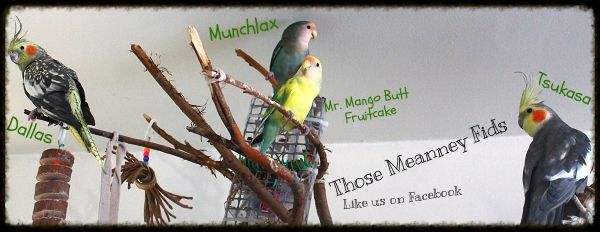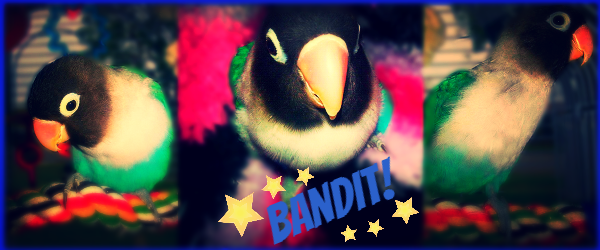Post by Casey on Oct 8, 2011 19:00:07 GMT -8
Masked Lovebirds, also called Yellow Collared Lovebirds, are predominantly green with a yellow collar and black face in the wild. They have a white eye ring, which is why they are considered an "eye ring" species, as not all lovebirds have the eye rings. They are native to northeastern Tanzania. They are rumoured to be more aggressive than Peach Faced Lovebirds.
The nine species of lovebirds are:
Peach Faced Lovebird
Masked Lovebird
Fischer's Lovebird
Nyasa Lovebird
Black Cheeked Lovebird
Abyssinian Lovebird
Madagascar Lovebird
Red Faced Lovebird
Black-collared Lovebird
The Black-collared Lovebird is very very rare in the wild and is the rarest of all lovebirds.
Lovebirds can live between 15-20 years, though sometimes a little less and occasionally more than 20 years but that is uncommon. In the wild their lifespan is 5-7 years due to predation. Lovebirds measure up to 6-7". Some species are smaller. The Abyssinian is the largest lovebird.
They do best on a seed based diet, supplemented with some pellets and veggies, grains, legumes, and fruit. They need higher calcium, fat, and protein than most commonly kept small parrots. In the wild a main food source is figs and seeds and grasses. Variety is key in their diets and if introduced to new foods when young, they become good eaters and adding good foods in the diet is easier. Lovebirds can be the most stubborn creatures when it comes to getting them to eat something they do not want.
As for pet qualities, a handfed/handtame bird is best for being cuddly and friendly. Lovebirds do not have to be kept in pairs to be happy, though untame birds do better with pairs. A single tame lovebird will be happy as long as you have time every day to play and socialize with it. They need lots of toys and roomy cages.
Cage size for lovebirds:
Single, no smaller than 18"x18"x20" due to activity level.
For a pair, as big as you can get, no smaller than 30"x18"x24" as they need space in case they bicker (which is likely)
Bar spacing should be no more than 5/8" for peachies and no more than 1/2" for masked and fischer's as they are smaller than peachies.
They can be prone to plucking themselves and others and can be very aggressive towards other birds. They have been known to kill other lovebirds and even cockatiels and green cheek conures so they do not do well with other species. They like to bite toes so injury to feet with lovebirds are very common. They can bite toes off of other birds and even beaks off of other birds. So please do not cage any other species with lovebirds, and be very cautious caging a new lovebird in with your current lovebird. They are also a noisy species, though not overly loud.
Lovebirds are little clowns, love to play, and will hang upside down, climb headfirst down their cages, and just do the silliest things. Any toy they can beat up and throw around is a favourite as well as anything they can shred and destroy. They will make toys of just about anything.
The nine species of lovebirds are:
Peach Faced Lovebird
Masked Lovebird
Fischer's Lovebird
Nyasa Lovebird
Black Cheeked Lovebird
Abyssinian Lovebird
Madagascar Lovebird
Red Faced Lovebird
Black-collared Lovebird
The Black-collared Lovebird is very very rare in the wild and is the rarest of all lovebirds.
Lovebirds can live between 15-20 years, though sometimes a little less and occasionally more than 20 years but that is uncommon. In the wild their lifespan is 5-7 years due to predation. Lovebirds measure up to 6-7". Some species are smaller. The Abyssinian is the largest lovebird.
They do best on a seed based diet, supplemented with some pellets and veggies, grains, legumes, and fruit. They need higher calcium, fat, and protein than most commonly kept small parrots. In the wild a main food source is figs and seeds and grasses. Variety is key in their diets and if introduced to new foods when young, they become good eaters and adding good foods in the diet is easier. Lovebirds can be the most stubborn creatures when it comes to getting them to eat something they do not want.
As for pet qualities, a handfed/handtame bird is best for being cuddly and friendly. Lovebirds do not have to be kept in pairs to be happy, though untame birds do better with pairs. A single tame lovebird will be happy as long as you have time every day to play and socialize with it. They need lots of toys and roomy cages.
Cage size for lovebirds:
Single, no smaller than 18"x18"x20" due to activity level.
For a pair, as big as you can get, no smaller than 30"x18"x24" as they need space in case they bicker (which is likely)
Bar spacing should be no more than 5/8" for peachies and no more than 1/2" for masked and fischer's as they are smaller than peachies.
They can be prone to plucking themselves and others and can be very aggressive towards other birds. They have been known to kill other lovebirds and even cockatiels and green cheek conures so they do not do well with other species. They like to bite toes so injury to feet with lovebirds are very common. They can bite toes off of other birds and even beaks off of other birds. So please do not cage any other species with lovebirds, and be very cautious caging a new lovebird in with your current lovebird. They are also a noisy species, though not overly loud.
Lovebirds are little clowns, love to play, and will hang upside down, climb headfirst down their cages, and just do the silliest things. Any toy they can beat up and throw around is a favourite as well as anything they can shred and destroy. They will make toys of just about anything.







